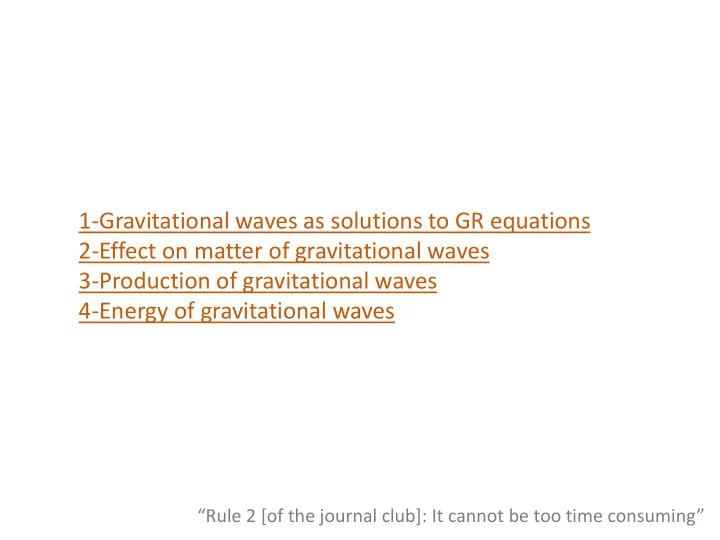

1-Gravitational waves as solutions to GR equations 2-Effect on matter of gravitational waves 3-Production of gravitational waves 4-Energy of gravitational waves “Rule 2 [of the journal club]: It cannot be too time consuming”
1-Gravitational waves as solutions to GR equations Small perturbations h around the Minkowski metric (“nearly Lorentz coordinate systems”): Linearize all expressions on the perturbation h. It is common to work with the following quantity instead: (h and h-bar actually are the same in a particular gauge)
GR is a mess because one can have any coordinate system. One can do Lorentz transformations and Gauge transformations to simplify expressions: In the Lorentz gauge, But this does not exhaust gauge freedom
(gauge) Long story made short, Einsteins equations are In the vacuum, T=0 of course. The solutions are a combination of the following plane waves: But we haven’t spent completely the available gauge freedom. We can further enforce this: Transverse-traceless gauge
So, in this gauge, we have just described a (gauge) (gauge) plane transverse wave, travelling at the (gauge) speed of light If we take U to be a timelike vector, and k to be in the z direction …
2-Effect on matter of gravitational waves: (gauge) Consider two particles (gauge) separated by Dx, Dy (gauge) It can be easily shown that the separation changes as follows with time: If hxy=0,we have “+ polarization”: If hxx =0, we have “x polarization”: (effect of the wave on a ring of particles in the transverse plane [x-y plane])
So with a resonant detector, one can in principle detect GWs (gauge) (gauge) Consider two masses with a spring (gauge) forming a harmonic oscillator with drag (length changes as the GW passes, and that generates a force)
Tuning the frequency of the oscillator to the frequency Omega of the wave, (gauge) one gets a resonance (gauge) (gauge) Typical numbers in the 60s: For A=10^-20, m=1.4 10^3 kg l0=1.5 m R_ress =10^-15 m Omega=10^4 s^-1 E_ress=10^20 J (!) Q=10^5
3-Production of gravitational waves Consider that the energy-momentum tensor has an oscillation with (gauge) frequency Omega: (gauge) (gauge) Quadrupole moment of the source mass distribution
Example one : two masses m oscillating in the x-axis, with average separation (gauge) l0, and frequency omega (gauge) (gauge) “+” polarization in the z direction “+” polarization also in the y direction, but no waves in the x direction Producing GWs in the lab? Let’s see… Too small … let’s turn m = 10^3 kg, l0 = 1 m, A = 10^-4 m, omega=10^4 s^-1 to the Cosmos then produces a wave h~10^-34/r (r in meters)
Example two : binary system of two masses m, frequency omega, (gauge) separation of l0 (circular motion) (gauge) (gauge) “Now we’re talking!” circular polarization in the z direction “+” polarization along the orbit plane: Note that the GW frequency is double the binary system frequency
Consider the pulsar PSR 1913+16 which made Russell Hulse and Joseph Taylor very happy (gauge) (gauge) Orbital period= 27 10^3 s (gauge) m=1.4 solar masses Distance from us = 1.5 10^20 m h~10^-20
4-Energy of gravitational waves Do GWs carry energy? Yes. They deposit energy in the matter they (gauge) cross. Their amplitude should then (gauge) decrease as it crosses matter by (gauge) energy conservation. How does that happen? GWs put matter in motion (e.g. parts of a detector), and the motion of that matter in turn generates GWs which interfere destructively with the incoming GW We can calculate then the relation between the amplitude of GWs and its energy (that is your homework anyway … I’ll just give you the result)
In the particular case of a binary system, the GW luminosity L (energy (gauge) per unit of time) emitted is (gauge) (gauge) L This is in natural units; L(SI)=3.63 10^52 J/s x L(nat. units) In the case of the pulsar PSR 1913+16, L=1.7 10^-29 That is around 0.1% of the Sun’s luminosity in EM radiation (but the real number is closer to 2% [why? next slide])
This will deplete the total energy E (potential+kinetic) of the binary (gauge) system (gauge) (gauge) The orbital period T will shrink: For pulsar PSR 1913+16, this comes out as -6 10^-6 s/year. The real rate is 12 times bigger because the orbit of the binary system has a significant eccentricity (e=0.617).
By Christopher Moore, Robert Cole and Christopher Berry from the Gravitational Wave Group at the Institute of Astronomy, University of Cambridge
Recommend
More recommend